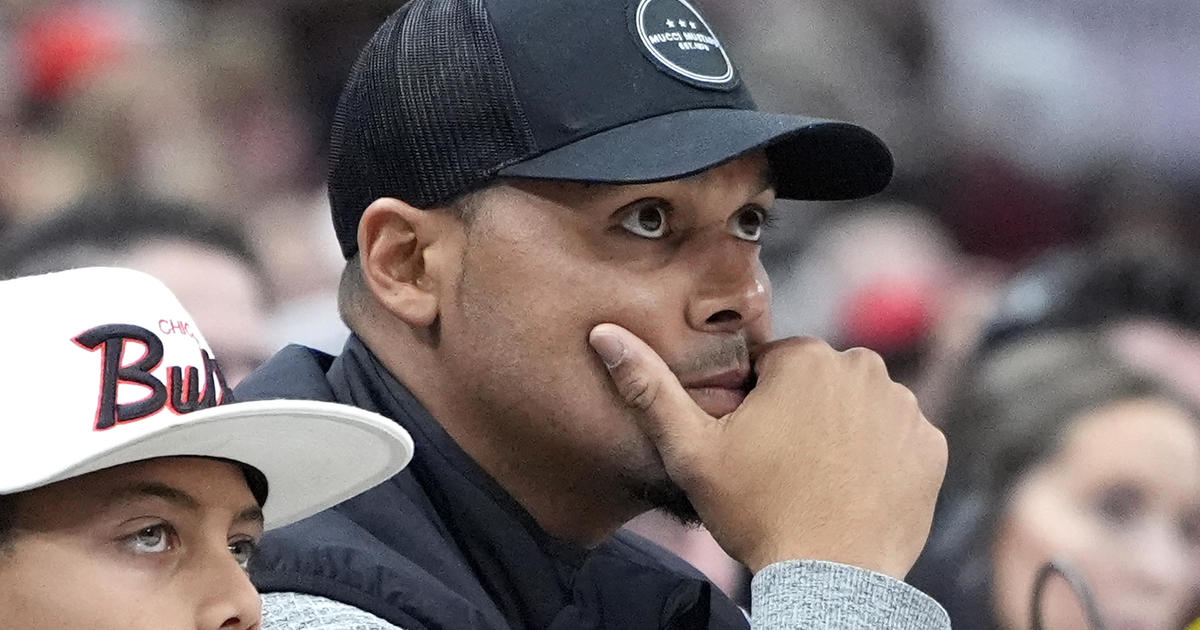Durkin: Bears' 2014 Free Agency Primer
By Dan Durkin-
(CBS) For fans, the holiday shopping season is a distant memory. Credit cards are paid off, hopefully, and decorations are packed away in the attic.
For NFL front offices, a holiday shopping spree is just days away. The 2014 free agent frenzy - and new league year - kicks off at 3 p.m. on Tuesday.
The intrigue of free agency lies in how it affords fans a glimpse of how their favorite team views its own imperfections. Each free agent signing is a mixture of guarded optimism splashed with a muted admission of failure.
From Jacksonville to Seattle, where the euphoria of winning it all is only four weeks old, major decisions are being made with next season in mind.
Locally, the Bears have an immense challenge ahead.
After spending a decade trying to win with defense and special teams, the offense finally caught up last season, but the defense deteriorated, giving up franchise-high totals in both points and yards allowed. Can general manager Phil Emery calibrate both sides of the ball?
An optimistic way to look at the impending rebuild on defense is how quickly the Bears were able to rejuvenate the offense under head coach Marc Trestman. But do they have the same caliber of coaches on defense to coordinate a change involving multiple new pieces?
The list of questions is long and difficult, but many will be answered soon. Let's take a look at how the Bears are positioned for the 2014 offseason and touch upon some other pertinent offseason topics.
Cap update
The 2014 salary cap limit has been set at $133 million per club. This is a massive, 8 percent jump from last season, but it cuts both ways. Teams who were in a cap quandary welcome the extra room, but the secondary market in high-demand positions could see inflated contract values.
With 54 players under contract, the Bears will start the 2014 offseason with an estimated $6.9 million in free cap space.
This total assumes the Bears elect to carry over all of the cap dollars they didn't spend in 2013, which totaled $746,727. The Bears will also carry $2.2 million in dead money - think Gabe Carimi, Adam Podlesh, Brandon Hardin, Evan Rodriguez, etc. - as well into 2014.
Only a handful of teams - such as the Chargers, Saints, Cowboys and Steelers - have less available cap space than the Bears heading into free agency.
The Bears roster reshaping is in full swing. Podlesh, a punter, has been released ($1.45 million cash savings, $1.025 cap savings), and defensive tackle Jeremiah Ratliff signed a two-year deal worth a reported $4 million with $600,000 guaranteed. Decisions about players like defensive end Julius Peppers ($14 million cash savings, $9.8 million cap savings) and running back Michael Bush ($2.85 million cash savings, $1.85 million cap savings) are in the offing, so more cap room can -- and likely will -- be created.
Rule of 51
Recall if you will that in the offseason, specifically from March 11 to Sept. 4, the Rule of 51 is in effect. This rule stipulates that only the top 51 contracts are accounted for in the offseason period.
However, once the regular season starts, all contracts – including practice squad players – count against the salary cap. Currently, the Bears have 54 players under contract, and the projected cap figure above includes only the Bears' top 51 salaries.
Negotiating period starts Saturday
As it was in 2013, the NFL has instituted a three-day negotiating period prior to free agency. This allows teams and agents of unrestricted free agents the opportunity to discuss contract terms and jockey to be the first visit on a free agent's docket.
Agents already have a feel for what positions teams are in the market for, as discussions originated during the week of the Senior Bowl, then amplified at the NFL Scouting Combine. But by having this negotiation window, teams can wait to disclose their specific contract figures. If they release this information too soon, agents will then shop that offer around, which could ultimately cost a team an opportunity to sign a player they coveted.
June 1 cuts
June 1 is a frequently mentioned date during free agency. It specifically refers to the "acceleration" provision in the collective bargaining agreement (CBA), article 13, section 6, paragraph 5 (ii).
To summarize, the acceleration provision allows teams to either designate two players as June 1 cuts or outright cut players on or after June 1, to spread their remaining dead money over two seasons. Thus, this is a useful tool for teams in a cap crunch that have a player whose dead money exceeds the cost to keep them on the roster.
The misconception that needs to be cleared up about this provision is the money is not available immediately. The salary of a player who is designated as a June 1 cut remains on the books in full until that date.
Cash versus cap
The new CBA remains a "soft" cap. Yes, each team is required to stay under the cap limit -- $133 million for 2014 -- but teams can exceed this amount in cash spending.
To explain, cash is comprised of base salary, roster and workout bonuses, which are all non-guaranteed dollars. When a player is signed to a new contract, the focus is always the guaranteed money. This money is paid out immediately to the player in cash. For accounting purposes, the cap portion, however, is prorated over a maximum of five years.
Take for example, Jermon Bushrod. Last offseason, Bushrod signed a five-year deal with the Bears worth $35.965 million, with an $11 million dollar signing bonus (guaranteed money), a $100,000 annual workout bonus and a veteran minimum base salary of $715,000 in the first year.
Thus, in 2013, Bushrod was 11th on the Bears in terms of his cap number of $3.015 million ($2.2 million prorated signing bonus + $715K base salary + $100K workout bonus), but was second on the team in terms of his cash number of $11.815 million ($11 million signing bonus + $715K base salary + $100K workout bonus).
The focus is typically on the cap number, but for free agency, the cash number is just as important in terms of luring free agents with up-front money.
Market for need positions
The Bears have a laundry list of needs, but their most pressing needs are at defensive end and safety. Using the 2013 free-agent deals at these two positions shows some interesting production-to-pay ratios.
Given the dollars spent relative to production, one could argue that the 2013 defensive end market generated the best free-agent values. The top deal went to Elvis Dumervil, who signed a five-year deal with the Ravens worth $35 million, with $11 million guaranteed. Dumervil finished the season with 9.5 sacks.
The next two deals worth looking at belong to the Super Bowl champion Seahawks. The Seahawks secured Cliff Avril with a two-year deal worth $15 million, with $6 million guaranteed. Avril finished with eight sacks and five forced fumbles.
Additionally, the Seahawks signed Michael Bennett to a one-year deal worth $4.8 million, with $1.5 million guaranteed. Bennett finished with 8.5 sacks and was versatile enough to kick inside to defensive tackle in nickel sub packages.
Looking at the 2014 defensive end class, it's lacking in both top-tier talent and depth. Greg Hardy (Panthers) and Brian Orakpo (Redskins) have been given the franchise tag, leaving Michael Johnson (Bengals) as the best available talent on the market. In terms of pass rush productivity, Johnson had a down year in 2013 but was stout against the run. He figures to fetch a premium in free agency.
The value at defensive end could come in the secondary market, where players like Lamarr Houston (Raiders), Everson Griffen (Vikings) and Willie Young (Lions) could be had for reasonable prices.
2013 was a great year to be a free agent safety. Money was flying for third-level defenders, evidenced by their 22 percent jump in franchise tag values from 2013 ($6.916 million) to 2014 ($8.433 million).
The Bucs lured Dashon Goldson from the 49ers with a five-year deal worth $41.5 million, with $22 million guaranteed. LaRon Landry parlayed a strong 2012 season with the Jets into a four-year deal with the Colts worth $24 million, with $14 million guaranteed, and the Falcons kept William Moore around with a five-year extension worth $30 million with $14 million guaranteed.
Looking at the production-to-pay ratios for that group shows the 2013 safety class was grossly overpaid.
For 2014, the safety class is easily the deepest of all positions. The marquee free agent is Jairus Byrd (Bills), but he's joined by T.J. Ward (Browns), Donte Whitner (49ers), Antoine Bethea (Colts), Louis Delmas (Lions) and Malcolm Jenkins (Saints).
While the top-shelf talent -- Byrd and Ward -- figure to make money equal to the top deals from 2013, the depth of this class should generate some great value in the second and third waves of free agency.
Final thoughts
The Bears have maintained their focus will be to get younger on defense, particularly through the draft; however, they must give themselves some margin for error, which means being active-yet-prudent in free agency.
Cap management has never been the Bears' issue, as Cliff Stein is one of the best in the business. The Bears' focus must center around talent identification, procurement and development.
Entering his third year on the job, Emery has done an admirable job retooling the offense via free agency, trades and the draft. It's time for him to demonstrate the same prowess on defense.
Follow Dan on Twitter: @djdurkin



